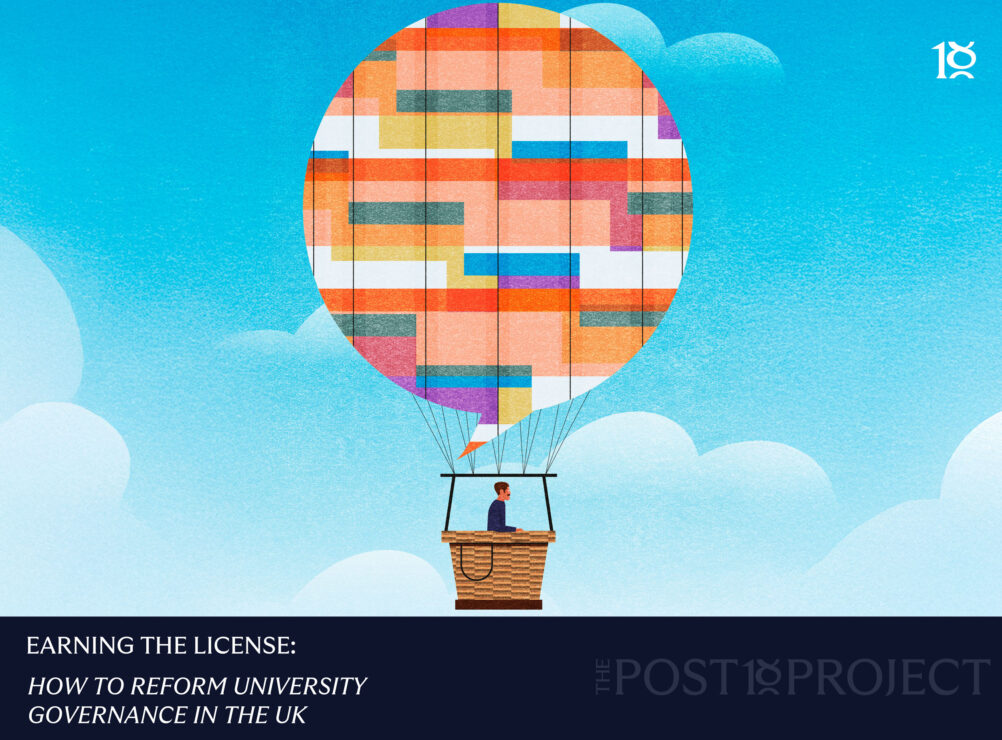The publication of the Office for Students’ response to Susan Orr’s review of blended learning, and of the review itself, neatly fits the pragmatism of the political moment.
There’s no ideology here – none of the absolutism that has often characterised the debate about blended learning – just a set of 23 recommendations that largely cleave to established good practice. All accompanied by a hopelessly simplistic “student-facing” YouTube video accompanied by what sounds like a knock-off of Mr Blue Skies. Where did we go wrong?
Four secretaries of state ago
Back in March, the exercise kicked off very differently. As usual, a gale of press coverage – this time about students deprived of the clear pedagogic superiority of face-to-face provision by rapacious universities – caught the attention of ministers, and a review was offered to:
set out where [blended] approaches represent high quality teaching and learning, as well as approaches that are likely to fall short of the OfS’s requirements.
It was an unusual move from a regulator that is usually keener to claim it is interested in outputs rather than methods. There’s a perfectly reasonable world in which the regulator could have responded by pointing to the data and claiming there was no need for it to act.
However, OfS did act – because there was a grain of truth to the criticisms beyond the anti-mask anti-vaccine “back to normal” rhetoric. The 2021-22 academic year was greatly affected by the prevalence of Covid-19, and by measures used to contain the spread of the virus.
It is inconceivable that every nuanced module-level decision between Zoom and the room was the right one – and we know that certain groups of students (those expecting practical experience in studios, or in the workplace) did miss out on key parts of their course.
Qualitative rules
The story OfS likes to tell is that it is a data-driven and evidence based regulator. Indeed, an April update from Susan Lapworth on this review pointed to evidence from the National Student Survey that could have been brought to bear on the issue. It wasn’t.
Instead, qualitative methods prevailed. Students and staff from six providers (we are not told which), covering 16 courses across four broad subject areas (humanities; medicine and allied health; natural sciences and engineering; and performing arts), were interviewed on issues ranging from the student experience and student learning behaviours to the practicalities of learning design.
The design of the research took pains to ensure some diversity across tariff groups, institutional typology, and geography – but with just six providers and 16 courses involved there’s no sense in which findings can be seen as fully representative.
At the time we criticised the review on Wonkhe for not including a student investigator – as it turns out Molly Lawson from the OfS student panel joined the Orr and team midway through after an initial member dropped out for personal reasons. It appears that the student panel played an active role in the earlier, evidence gathering process too – sitting in on interviews with staff and facilitating interviews with students. It’s fair to say the picture on whether students are to be regarded as “experts in their own experience”, or events administrators, remains unclear.
We also criticised the review for the “issue of the week” framing and the implication that the sector was once again in for a regulatory (and ministerial) kicking. This has not come to pass. Instead the report is genuinely impressive (given the limitations in coverage described above) – situated in pedagogic scholarship and displaying a welcome sense of history.
Defining the blend
Blended learning, after all, did not emerge during the pandemic fully formed. The first fully online course was run in the UK in the early 80s – it’s difficult to identify the first “blended” course as approaches used within the Open University’s DT200 were trialled and pioneered elsewhere. By the mid to late 00s, every course in UK higher education was blended learning – with materials and resources shared electronically for students to access on demand.
All this falls within the definition of blended learning chosen by Susan Orr (via Michael Barber):
Blended learning is teaching and learning that combines in-person delivery and delivery in a digital environment.
(for completeness, Orr adds to this an idea of intentionality – a “thoughtful integration” of digital and in-person delivery – via the work of Garrison and Kanuka)
The meat of the report, therefore, takes a 2022 temperature on how students feel about the various digital components of their courses – with the blanket finding that there are both strengths and weaknesses to digital and digitally-enabled delivery. Again such findings are hardly new, but it is important that they are restated.
Good teaching matters, the mode less so
Students, for instance, appreciated the convenience of being able to watch a lecture on demand, but missed the opportunity to participate actively in discussions in person. Students appreciated the accessibility of online resources (the report makes a welcome note of the increasing, publisher-driven, cost of providing digital textbooks).
Students reported that course planning meant that they often faced periods of unsustainable workload and an over-abundance of resources they felt they had to engage with. And, perhaps contrary to expectations about the speed of digital, some students reported difficulties in getting timely feedback – perhaps the brutal increases in workloads for academic had an impact here..
Providers are investing – in general, thoughtfully and with pedagogic and access benefits in mind – in digital tools and resources. Online and blended learning strategies exist (again, as they have for years) in various states of actionability – training and support for staff in using digital tools is generally available but may not always be timely or appropriate.
Fundamentally, both good teaching and poor teaching practices exist – both online and offline. Student feedback on the mode of delivery was in many ways secondary. If last year’s lecture was amazing students are likely learning more from a well-made recording (and enjoying the experience more) than those watching a badly prepared and delivered live lecture. And a boxed set of badly recorded lectures at the start of a course could be less satisfying than an intelligently planned series of live seminars and digital resources.
Anti-growth coalition?
You’ll recall the accusation that universities had moved provision online to “save money” (actually to deal with a larger than expected entry cohort due to the examnishambles in the face of a declining unit of resource and a sharp rise in the costs of expanding physical space – all issues that were clear at the time and saw no regulatory action whatsoever). The review does not address this issue in depth – it does say it saw some evidence that decisions about the use of digital delivery was spurred by an unexpected increase in numbers – but recommends that:
Providers should ensure that growth in student numbers does not drive the approach to blended learning and that, instead, the blended approach should be informed by sound pedagogic principles.
Orr cautions against drawing conclusions from the clearly exceptional events of 2020, 2021, and 2022 – the report as a whole rightly sees nothing sinister about the use of blended approaches where literally no other options were available to teach students who met the contractual conditions of their offer in numbers beyond the capacity of the campus (you may recall that universities were told to expect A level results in a similar distribution to previous years).
We add in parenthesis that we are on the cusp of another expansion of student numbers driven by demography – while the unit of resource continues to decline and (unlike for 16-19 education) no measures have been put in place to manage or support the required growth in capacity. Blended approaches most likely have a role to play in that future too.
The regulator responds
The Office for Students response to the Orr report takes the report recommendations (which are directed entirely to providers) and applies them using the lens of registration conditions B1 and B2 (and C1 on consumer protection). This approach allows them to opine loftily that the use of pre-recorded lectures or other online approaches where a course substantially over-recruited in 2021-22 is “likely to be of concern” without making any suggestions regarding what measures the provider in question should have taken instead.
Just to run through the other options available at the time – a provider could have breached CMA guidance and an enforceable contract by not recruiting students it had previously made offers to (we recall Michelle Donelan and the regulator itself being quite vocal on that issue), or it could have somehow conjured up additional campus capacity at a moment’s notice through global (and UK specific) logistics, supply, and labour issues.
It is, to be clear, very welcome to see OfS stepping out from behind the shield of outcomes metrics to offer clues as to what kinds of teaching activity and facilities to support it that it does (and does not) find acceptable – we’d even be glad to see this approach extended outside the realms of blended learning.
But the response and report overall does not give us hope that anyone has been planning or thinking about expanding the sector to meet applicant demand. This report and the response should be seen as flagging one likely impact of this failure.
Threshold metrics
More generally, taken together what the two reports can be seen to represent is a sharp contrast with the enhancement-led approach treasured by the devolved nations and the Quality Assurance Agency.
There is a healthy debate about whether competition, collaboration or guidance can drive best practice above a minimum, that often plays out on this site. But what we’re starting to see here is some flesh on the definition of a minimum – the sorts of things that students have the universal right to – at a level of granularity not really seen for some time from the enhancement-led approach.
If OfS continues in this vein of better defining what all students should experience, both with aspects of provision and across particular subject areas, a failure of devolved nations regulation to spot and call out the unacceptable is going to start to look decidedly problematic as the sector continues to rapidly expand to cope with a similarly rapidly declining unit of resource.















Molly Lawson (mentioned above as the OfS student panel member that joined the Orr team midway through) according to her LinkedIn page joined the review panel in July 2022, which is the same time she stopped being a student panel member (and stopped being a student). Since September 2022 she’s been a “Leadership Development Officer” at OfS.
So at the time she was part of the Orr panel, she wasn’t on the student panel or a student. But during part of the time that she was on the Orr panel, she was an OfS employee.
“We add in parenthesis that we are on the cusp of another expansion of student numbers driven by demography – while the unit of resource continues to decline and (unlike for 16-19 education) no measures have been put in place to manage or support the required growth in capacity.” It’s simple, the current world situation means our current high-income generation ‘overseas’ (Chinese predominately) cash-cows will soon be unable to come and fill the space in the existing capacity, so continual expansion, and the associated debts for construction etc, may not be in the Universities best interests IF they are paying… Read more »
I welcome the review and the recommendations but there is a still a lack of clarity around what constitutes “delivery” by the OfS who define blended learning as “‘teaching and learning that combines in-person delivery and delivery in a digital environment”. So if we perceive “delivery” to be everything that a student has access to as part of their learning then I’d imagine that 99.999% of courses in the UK would be considered blended, given that almost every student has access to course materials outside of the taught sessions as part of their “self-directed” study hours. However, if we interpret… Read more »
Having had “Mr Blue Sky” (not “Skies”) as the first dance at our wedding, the pedant in me can’t let that mistake pass without comment…sorry! 🙂
But you are so right that it does indeed sounds like a cheap knock-off version (or maybe the karaoke version?). That made me chuckle.